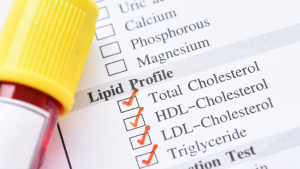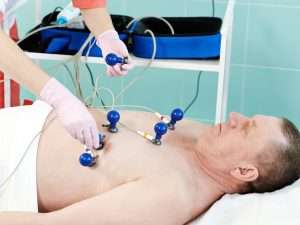Maintaining a healthy lipid profile is crucial for heart health and overall well-being. Lipids, including cholesterol and triglycerides, play essential roles in the body, but imbalances can increase the risk of heart disease and other health complications. In this blog, we’ll explore what a lipid panel is, its purpose, and natural ways to improve your lipid profile for better health.
Table of Contents
What Is a Lipid Panel?
A lipid panel is a blood test that measures the levels of different fats in your blood. These fats, or lipids, include cholesterol and triglycerides, which are essential for various body functions but can be harmful when present in excess.
What Is the Purpose of a Lipid Panel?
The primary purpose of a lipid panel is to assess your risk of heart disease, stroke, and other cardiovascular conditions. It helps healthcare providers evaluate your cholesterol levels and determine whether lifestyle changes or medications are needed.
What Are the Key Components of a Lipid Profile?
The key components of a lipid profile include:
- Cholesterol: Balancing LDL and HDL levels is essential.
- Triglycerides: Lowering triglyceride levels reduces heart disease risk.
- Lipoproteins: Transport lipids through the bloodstream and impact cardiovascular health.
What Are the Five Tests in a Lipid Panel?
A standard lipid panel typically includes:
- Total Cholesterol: Measures the overall cholesterol level in your blood.
- LDL Cholesterol (Low-Density Lipoprotein): Often called “bad cholesterol,” high levels can lead to plaque buildup in arteries.
- HDL Cholesterol (High-Density Lipoprotein): Known as “good cholesterol,” it helps remove excess cholesterol from the bloodstream.
- Triglycerides: A type of fat that provides energy but can increase heart disease risk if elevated.
- VLDL Cholesterol (Very Low-Density Lipoprotein): A type of cholesterol linked to triglyceride levels and plaque formation.
Why Do I Need a Lipid Panel Blood Test?
A lipid panel is essential for:
- Routine Health Monitoring: Helps track cholesterol and triglyceride levels over time.
- Identifying Risk Factors: Detects early signs of heart disease and atherosclerosis.
- Guiding Treatment Plans: Determines whether lifestyle changes, medications, or both are necessary.
How Lipid Imbalances Increase Heart Disease?
Lipids primarily affect the heart and blood vessels. Excess cholesterol and triglycerides can lead to plaque buildup in arteries, increasing the risk of:
- Heart attacks
- Strokes
- Peripheral artery disease
When Should You Check Your Lipid Profile?
Testing recommendations include:
- Adults (20 years and older): At least once every 4-6 years.
- High-Risk Individuals: More frequent testing for those with a family history of heart disease, obesity, or diabetes.
- Children and Teens: Testing may be recommended if there’s a strong family history of high cholesterol or early heart disease.
What to Eat the Night Before a Cholesterol Test
What Are the Next Steps if My Lipid Panel Results Are Abnormal?
If your lipid panel results are outside the normal range, your healthcare provider may recommend:
- Lifestyle Modifications: A healthier diet, regular exercise, and weight management.
- Medications: Such as statins or fibrates to lower cholesterol levels.
- Further Testing: Additional tests to rule out underlying conditions.
What Natural Foods Can Help Improve Your Lipid Profile?
Certain foods can naturally lower cholesterol and improve your lipid profile, including:
- Oats and Whole Grains: Rich in soluble fiber to reduce LDL cholesterol.
- Fatty Fish: High in omega-3 fatty acids, which improve HDL levels.
- Nuts and Seeds: Provide healthy fats and reduce bad cholesterol.
- Fruits and Vegetables: Loaded with antioxidants and fiber for better heart health.
- Legumes: Lowers LDL cholesterol and boosts overall heart health.
When Should You Seek Professional Help?
If lifestyle changes don’t significantly improve your lipid profile within a few months, it’s time to consult a healthcare provider. Persistent abnormalities might require medications or further evaluation to address underlying issues.
Conclusion
A healthy lipid profile is vital for heart health and overall well-being. A lipid panel measures cholesterol and triglyceride levels to assess your risk for heart disease. Natural ways to improve your lipid profile include eating fiber-rich foods, increasing physical activity, and maintaining a healthy weight. If lifestyle changes alone are not enough, professional evaluation and treatment may be necessary.
For personalized support and expert guidance on improving your lipid profile, schedule a consultation with The Heartbeat Clinic. Our team is here to help you take control of your heart health naturally and effectively.
FAQs
1. Is it safe to get a lipid profile test during pregnancy?
Yes, lipid profile tests are generally safe during pregnancy, but lipid levels may naturally fluctuate due to hormonal changes.
2. How can I improve my lipid profile?
You can improve your lipid profile through a healthy diet, regular exercise, weight management, and stress reduction.
3. How to reduce cholesterol in 7 days naturally?
Focus on eating foods rich in fiber, healthy fats, and antioxidants, while avoiding processed and fried foods. Drink plenty of water and stay physically active.
4. What improves blood lipid levels?
Foods like fatty fish, nuts, seeds, whole grains, and legumes improve blood lipid levels. Regular exercise and weight control also help.
5. What cleans cholesterol out of your body?
Fiber-rich foods like oats and fruits help bind cholesterol in the digestive system and remove it from the body.
6. What are the 5 signs of high cholesterol?
Common signs include chest pain, fatigue, difficulty breathing, numbness in extremities, and yellowish deposits around the eyes (xanthomas).
7. Are bananas good for lipids?
Yes, bananas are low in saturated fats and rich in potassium, which supports heart health.
8. What’s the ideal LDL level for heart health?
For most adults, an LDL level below 100 mg/dL is considered optimal.
9. Can stress affect lipid levels?
Yes, chronic stress can raise LDL levels and lower HDL levels, increasing cardiovascular risks.
10. How long does it take to improve your lipid profile?
Improvements can be seen within a few weeks to months, depending on the consistency of lifestyle changes.
Medical Disclaimer
This article is intended for informational purposes only and is not a replacement for professional medical advice. Always consult a qualified healthcare provider regarding your specific condition and treatment options.






